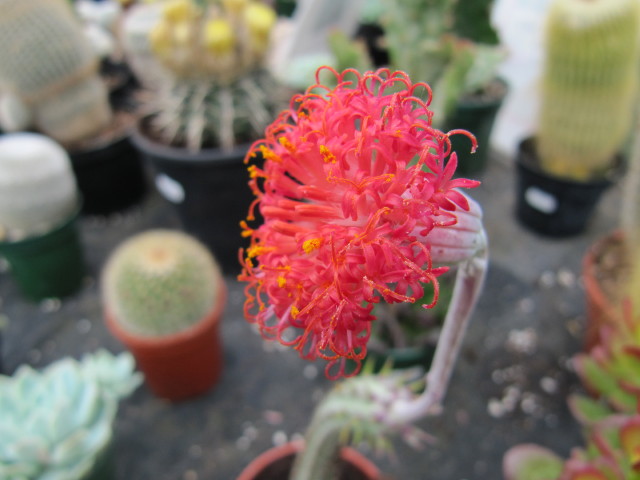The Senecio stapeliiformis is a very decorative succulent plant, suitable for pots or gardens. In fact, it is widely used as a rockery plant, as its water needs are low.
The Senecio genus is from the Asteraceae family; it comprises hundreds of species spread throughout the world.
Senecio stapeliiformis is commonly called Senecio stapelia because of its resemblance to plants of the genus Stapelia.
It is a plant native to southern and eastern Africa.
They are curious succulent plants with erect and branched stems that barely exceed 25 to 30 cm in height.
These stems have 5 to 7 ribs and are green and gray with longitudinal dark lines and tiny, scale-shaped leaves.
Its red flowers are very showy and persistent. They bloom towards the end of summer and the first half of fall.
Flowering generally occurs in spring, between April and May.
Although they are often used in pots and planters for patios and terraces, they are also grown as indoor plants or in rockeries and cactus and succulent gardens.
Senecio stapeliiformis Care
You will enjoy caring for this succulent is quite easy.
Illumination
It needs to receive a lot of indirect light, although it can take a few hours of direct sunlight.
The best time to place the Senecio stapeliiformis in the sun is when the rays are least powerful, as this will prevent the plant from burning.
Temperature
Senecio stapeliiformis is comfortable in temperatures between 16ºC/60°F and 25ºC/77°F. That is to say; they like warm climates.
It has no problem withstanding higher temperatures as long as it’s properly water.
However, what it doesn’t tolerate are temperatures below 10ºC/50°F.
For this reason, it is common to grow indoors.
Substratum
Senecio are plants that take advantage of a good fertile substrate, with the addition of peat and sand to make the soil more draining since they do not support waterlogging.
They also thrive well with sandy soils, so a substrate based on 60% siliceous sand and 40% leaf mulch would serve it well.
Watering
The most delicate point is irrigation. As a general rule, Senecio stapeliiformis needs little water because it is a succulent plant, it stores reserves in its leaves, and therefore it is not favored by excess watering.
It is also sensitive to root rot, so I recommend that you water it moderately and only when the substrate is completely dry.
Fertilizer
It’s advisable to fertilize in spring with some well-disposed manure.
You can also use specific commercial fertilizers for cacti and succulents.
Always trying to have the lowest concentration of chemical ingredients that can burn the plant.
Diseases
If you water and care for your Senecio correctly, you won’t see any diseases, but if you do, you can use insecticide for pest.
Propagation
Fortunately, Senecio stapeliiformis is fairly easy to propagate. Also, I have good news… damaged stems or rotting roots also spread!
If you want to multiply your Senecio, cut a stem of about 10 centimeters.
Once cut, place it on the substrate of a pot, making sure that the cuttings are in contact with the soil.
Cover them with a little bit of dirt, so they don’t move.
Next, wet the soil until it is quite wet and cover the pot with a freezing bag or plastic to increase the temperature.
This way, keeping the soil humid and high temperature, our cutting will “grab” and give way to a new plant in about two or three weeks.
Pruning
They are plants that are not pruned. Only the parts that are gradually damaged or dried are removed to prevent parasitic diseases from being transmitted.
